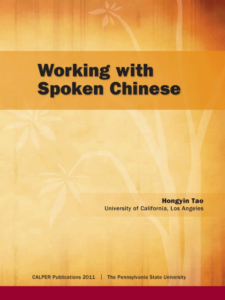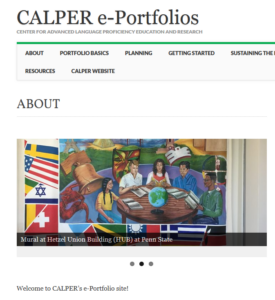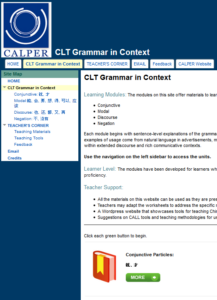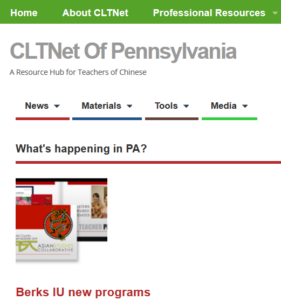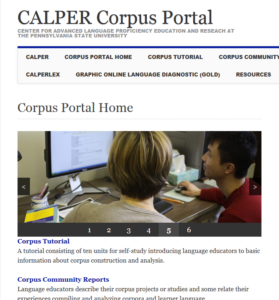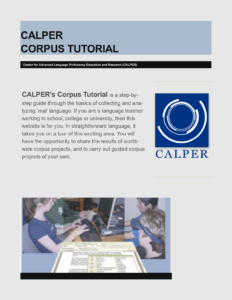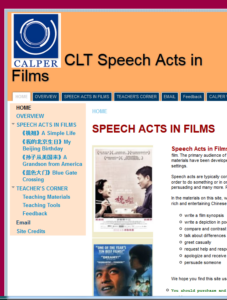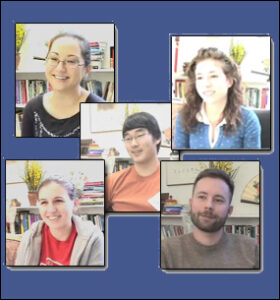A Casebook of Dynamic Assessment in Foreign Language Education
The Casebook provides detailed accounts of the experiences of two L2 classroom teachers with DA. The first case occurs in a primary school L2 Spanish class. Here, the teacher’s interest is to find a more systematic approach to providing feedback to learners as she interacts with them during daily classroom activities. As this case reveals, the teacher’s experience using DA also had unanticipated consequences for her thinking about the kinds of activities she wanted to engage learners in and the opportunities for language use that are valuable to her students. The second case involves an advanced university-level L2 Japanese writing course. The teacher turned to DA in order to make her use of a process approach to writing (including multiple drafts, writing conferences, and peer feedback sessions) more beneficial to her students. The result is a three-tiered approach to DA that includes individualized teacher-learner sessions, peer group work, and whole class DA interactions. For both cases, specific DA interactions are brought into focus and discussed. The interactions themselves are transcribed and included as part of the text.
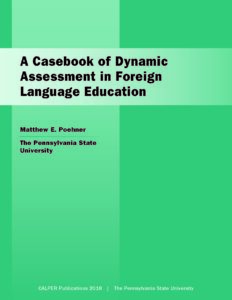
Advancing in Russian Through Narration
Pavlenko, A., & Driagina, V. (2008). Advancing in Russian through narration. University Park, PA: CALPER Publications.
The focus of Advancing in Russian through Narration is on two important components of advanced foreign language proficiency, narrative and conceptual proficiency.
Narrative proficiency refers here to the ability to tell narratives that are similar to those of native speakers of Russian. Conceptual proficiency refers to the ability of making the same conceptual distinctions as native speakers of Russian do.
Our discussion singles out five areas of Russian language knowledge central to acquisition of narrative and conceptual proficiency. Two of these areas, namely the use of tense and aspect and the use of verbs of motion, are well-known in the field of Russian instruction as areas of particular difficulty for English-speaking students.The other three areas, namely narrative structure, emotion vocabulary, and identity vocabulary, have not been much discussed in the literature on teaching Russian, to the best of our knowledge. Thus, the first contribution of this book to the literature on teaching advanced Russian is in drawing attention to areas of difficulty ignored previously. The second contribution is in drawing attention to narrative and conceptual proficiency as important components of advanced level proficiency.
Chapters:
Narratives in the Russian Classroom
Emotion Vocabulary
Verbs of Motion
Tense and Aspect in Narratives
Identity Terms in Narratives
Appendix: The Research Study
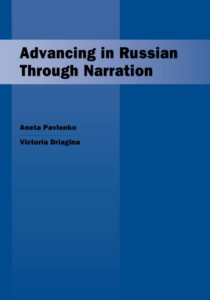
Assessing Language Development
Assessing Language Development is a website intended to familiarize language teachers with various approaches to assessing language development.
The forms of assessment described on our site are not particular to any given language but can be used with learners of any language, including Chinese, Russian, Japanese, Arabic, and Korean as well as more commonly taught languages like Spanish, French, and German and English as a Second Language.
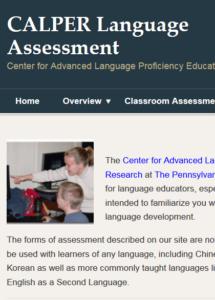
Assessment of Advanced Language Proficiency: Why Performance-based Tasks?
CALPER Professional Development Document CPDD 0605
In this document, Shohamy and Inbar argue for the use of performance-based tasks in the assessment of advanced language proficiency. In this effort, they start by exploring the ‘content/language continuum in language teaching programs’ (p. 1) and by discussing performance tasks. They also address issues regarding the designing and scoring of performance-based tasks, including rubrics. The document ends with examples of integrated content and language performance tasks, as well as guidelines for designing a performance task and a sample task.
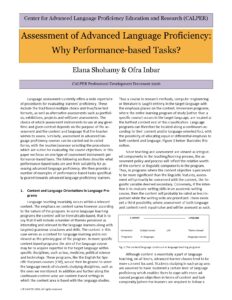
Publication Units:
Assessment of Advanced Language Proficiency-Why Performance-based Tasks?
Publication Files:
CALPER ePortfolios Resource site
A resource site on how to get started with using ePortfolios in language courses and programs. Still under development.
CALPER Newsletter
The CALPER Newsletter is a bi-annual publication of the Center for Advance Language Proficiency Education and Research (CALPER) at The Pennsylvania State University, a consortium between Penn State and the University of Pittsburgh.
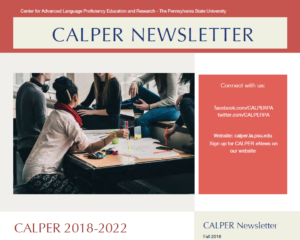
CALPERLEX Chinese
CALPERLEX is a series of worksheets that teachers can use in their course to explore language through corpus analysis. Teachers can find single lexical items or contrasting lexical pairs or routine expressions presented in form of concordance lines. The “problem set” can be printed out and used in the classroom. They can also be used by individual learners for self-study.
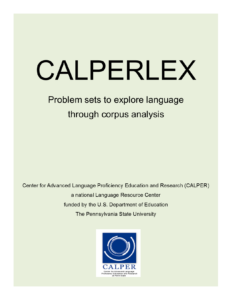
Publication Units:
CALPERLEX on “yizhi / shizhong”
CALPERLEX on “zaocheng / xingcheng”
Publication Files:
CALPERLEX Russian
CALPERLEX is a series of worksheets that teachers can use in their course to explore language through corpus analysis. Teachers can find single lexical items or contrasting lexical pairs or routine expressions presented in form of concordance lines. The “problem set” can be printed out and used in the classroom. They can also be used by individual learners for self-study.
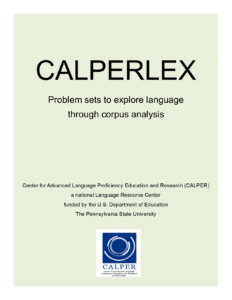
Publication Units:
CALPERLEX on “da ty chto”
CALPERLEX on “ukh ty”
Publication Files:
CALPERLEX Spanish
CALPERLEX is a series of worksheets that teachers can use in their course to explore language through corpus analysis. Teachers can find single lexical items or contrasting lexical pairs or routine expressions presented in form of concordance lines. The “problem set” can be printed out and used in the classroom. They can also be used by individual learners for self-study.
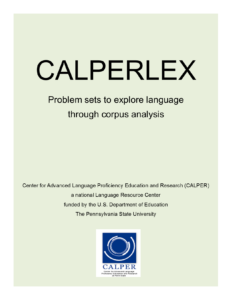
Publication Units:
CALPERLEX on “en fin / por fin “
CALPERLEX on “ir / irse”
CALPERLEX on “quedar / quedarse”
CALPERLEX on “en seguida”
Publication Files:
Chinese Corpus Resource Guide
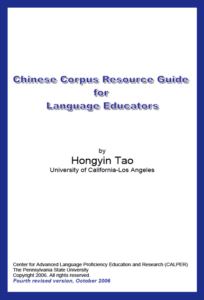
Publication Units:
Chinese Corpus Resource Guide_CALPER_2006
Publication Files:
CLT Grammar in Context
Grammar in Context are online materials for high-intermediate, low-advanced and advanced learners of Mandarin Chinese.
Grammar in Context includes Learn—Practice—Self-check and Vocabulary Support for 16 commonly used particles in Mandarin Chinese. The units can be used in blended learning environments, for self-study, and traditional classroom settings.
CLTNet of PA Resource Hub
This website is intended as a resource hub. Teachers will find i) information relevant to CLT in Pennsylvania, such as news from communities and institutions; ii) references to quality teaching materials; iii) sources for media in Chinese; iv) selected tools for teaching and learning, and more.
Subscribe to a feed and get notifications about new posts directly to your inbox.
Visit the site and join the network of teachers of Chinese in Pennsylvania.
Computer-mediated Learner Corpus Research and the Data-driven Teaching of L2 Pragmatic Competence: The Case of German Modal Particles
CALPER Working Paper Series, No. 4
The authors report on a three-week pedagogical intervention for the teaching of German modal particles, which draws on the methodologies of contrastive learner corpus analysis and data-driven learning. The intervention was administered in the context of a German-American telecollaborative partnership, an electronically mediated learning configuration in which geographically dispersed learners in parallel language classes use Internet communication tools in order to interact with one another on the completion of a variety of teacher-guided projects.
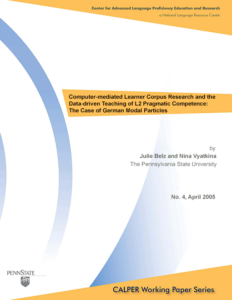
Publication Units:
Computer-mediated Learner Corpus Research and the Data-driven Teaching of L2 Pragmatic Competence: The Case of German Modal Particles
Publication Files:
Concept-based Instruction: Teaching Grammar in an Intermediate-Advanced Spanish L2 University Classroom
CALPER Working Paper Series, No. 3
This working paper focuses on the quality of the grammatical knowledge that is presented to learners in the classroom setting and how teachers can promote the appropriation of such knowledge by students. The approach proposed by the authors is predicated on the Vygotskyan principle that schooled instruction is about learners’ internalizing and developing control over theoretical concepts that are explicitly and coherently presented to them.
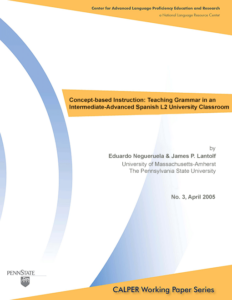
Publication Units:
Concept-based Instruction: Teaching Grammar in an Intermediate-Advanced Spanish L2 University Classroom
Publication Files:
Contemporary Study Abroad and Foreign Language Learning
This CALPER Publication is now available as a free downloadable PDF. Please note that the materials are copyrighted.
Kinginger, C. (2009). Contemporary study abroad and foreign language learning. University Park, PA: CALPER Publications.
This Guidebook explains why language educators and study abroad professionals should develop an activist stance in promoting language learning in study abroad programs, and provides tools to help promote meaningful sojourns abroad for their language students. These tools include knowledge about what aspects of language are best learned in host communities and about how successful students take advantage of study abroad to enhance their language ability. They also include stories about the kinds of conflicts students may encounter in interaction with their hosts, with guidance about how to turn these conflicts into opportunities for learning. Finally, this Guidebook offers specific suggestions for ways to prepare students for their stay abroad, to enhance their chances at success while abroad, and to nurture the abilities they have developed outside the classroom. Tasks and discussion topics are suggested throughout the Guidebook.
Chapter 1: Language learning in study abroad: An activist stance
Chapter 2: What students can learn in study abroad
Chapter 3: How students learn languages abroad
Chapter 4: ‘Rich points’: Stories about intercultural miscommunication
Chapter 5: Pitfalls for language learners abroad
Chapter 6: Extending engagement in language learning after study abroad
Further readings
Appendices
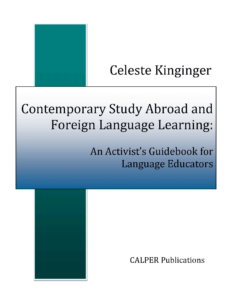
Publication Units:
Publication Files:
Corpus Community Reports
CALPER’s Corpus Community Reports consist of a set of documents where language educators describe their corpus projects or their studies and some relate their experiences compiling and analyzing copora and learner language. The Corpus Community Reports are intended to provide those interested in working with copora with first hand insights into projects of language teachers and researchers.
For more information on the use of corpora Go to our Corpus Portal Website
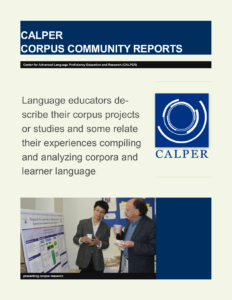
Publication Units:
No. 1 Working with a Spoken Burmese Corpus by San San Hnin Tun (Cornell University), 2007 [PDF]
No. 2 Discourse Markers in Turkish and English: A comparative study by Nurdan Gürbüz (Middle East Technical University, Turkey), 2008 [PDF]
No. 3 Thai Pop Music: A specialized corpus for the language classroom by Teddy Bofman and Paul Prez (Northern Illinois University), 2009 [PDF]
No. 4 Using a Corpus Effectively in a Spanish Grammar Course by Carlos Benavides (University of Massachusetts, Dartmouth), 2013 [PDF]
No. 5 Using Parallel Corpora in Teaching Chinese as a Foreign Language by Brody Bluemel (The Pennsylvania State University), 2013 [PDF]
Corpus Portal
CALPER’s Corpus portal is a gateway to information and tools for teachers interested in exploring ways in which natural language (compiled into a corpus) can be used in language teaching and learning and assessment. It can also provide quick and easy access to all corpus-related materials developed by CALPER.
Corpus Tools for Language Teaching
Presentation at the Penn State Language Teaching Workshop Series, 2014 – A review of Corpus tools used in language teaching. Slideshow focuses on useful Corpora for teachers, vocabulary, and more.
Corpus Tutorial
The tutorial consists of ten units of self-study devoted to corpus construction, basic corpus-analytical techniques and applications. Designed for language educators. It guides you step-by-step through the basics of collecting and analyzing ‘real’ language. If you are a language teacher working in school, college or university, then this website is for you. In straightforward language, it takes you on a tour of this exciting area. You will have the opportunity to share the results of worldwide corpus projects, and to carry out guided corpus projects of your own. In order to use this tutorial, you will need to have access to the Internet, a computer that uses Microsoft Word (details of versions that will support wordsmith), and basic computer skills.
Discourse Analysis
This introductory textbook presents a variety of approaches and perspectives that can be employed to analyze any sample of discourse. The perspectives come from multiple disciplines, including linguistics, sociolinguistics, and linguistic anthropology, all of which shed light on meaning and the interactional construction of meaning through language use. Students without prior experience in discourse analysis will appreciate and understand the micro-macro relationship of language use in everyday contexts, in professional and academic settings, in languages other than English, and in a wide variety of media outlets.
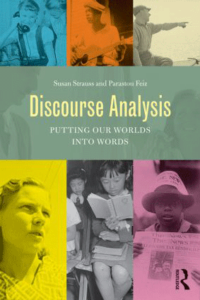
Dynamic Assessment and the Problem of Validity in the L2 Classroom
CALPER Working Paper Series, No. 10
This paper begins with the premise that classroom-based assessment often carries high stakes for teachers and learners but that the important matter of validating these assessments has not been fully addressed in the literature. The author argues that the work of L.S. Vygotsky and his colleagues, through the dynamic model of assessment, offers a principled approach to integrating teaching and assessment as well as a theoretical framework for reflections on the validity of this activity.
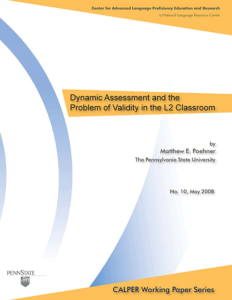
Publication Units:
Dynamic Assessment and the Problem of Validity in the L2 Classroom
Publication Files:
Dynamic Assessment in the Foreign Language Classroom: A Teacher’s Guide
Lantolf, J. P., & Poehner, M. E. (2011). Dynamic assessment in the foreign language classroom: A teacher’s guide. (2nd edition). University Park, PA: CALPER Publications.
Chapters Include:
- Foundations of Dynamic Assessment — introduces the general theory of human development, which originates in the writings of the Russian psychologist, L.S. Vygotsky.
- The Zone of Proximal Development — addresses this specific theoretical concept that is most immediately connected to DA
- Dynamic Assessment — presents the different approaches to DA that researchers and educators have developed since the concept was first introduced to North American audiences by Vygotsky’s colleague, A. R. Luria in 1961
- Dynamic Assessment and Second Language Learning — focuses on DA as it pertains specifically to foreign and second language education.
Review:
“Dynamic Assessment in the Foreign Language Classroom: A Teacher’s Guide (2nd edition) is a welcomed addition to a teacher’s professional library and can be used as a textbook for a course on foreign and second language assessment or as a complementary textbook in a course on language teaching methodology. The second edition of the teacher’s guide provides an accessible overview of the theory and practice of dynamic assessment. Lantolf and Poehner explain concepts from sociocultural theory that support the use of dynamic assessment, explore the zone of proximal development as the essential concept necessary for understanding and implementing dynamic assessment, and illustrate several approaches to dynamic assessment that meet diverse pedagogical needs. Enrichments activities in each chapter bring theory to life by involving the reader in the practice of specific theoretical concepts and analysis of the experience. Acknowledging that dynamic assessment may be difficult to conceptualize, the authors show how dynamic assessment differs from assessment practices where assessment and instruction are typically understood as distinct activities. Text-based and video case studies provide concrete examples of teachers engaged in successful and unsuccessful dynamic assessment sessions in various instructional contexts, such as tutorial sessions with university students of French and English as a second language, an elementary school science class for English language learners, and an elementary school Spanish class. Case studies provide examples of teachers tutoring individual students, interacting with small groups, and instructing whole classes for various instructional objectives, such as editing writing, developing listening comprehension ability, and spoken narration of past events. The case studies are thoroughly explained and analyzed and are followed by questions that are certain to prompt insightful discussions. Each chapter also contains enrichment activities and suggestions for further reading. I recommend this text highly to all language teachers at any level of instruction, to researchers specializing in language assessment, and to language program coordinators and administrators who deal with issues of testing and assessment, accountability, and teacher professional development.”
Richard Donato, Ph.D.
Department of Instruction and Learning
University of Pittsburgh
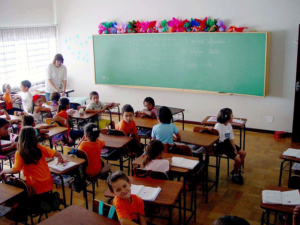
Dynamic Assessment in the Language Classroom
CALPER Professional Development Document (CPDD 0411)
In very clear language, the authors provide a basic account of Dynamic Assessment (DA) and trace its origins to Vygotsky’s theory of development. They explain the concepts of mediation and Zone of Proximal Development (ZPD), as well as the two main approaches used in DA. They also include three examples detailing what DA looks like in the classroom and conclude the document by providing a glimpse of what the future holds for DA, such as using it with groups and integrating computer technologies to DA procedures.
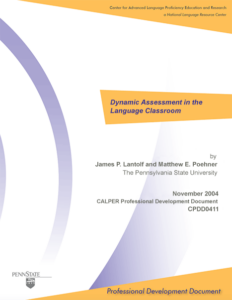
Publication Units:
Dynamic Assessment in the Language Classroom
Publication Files:
Dynamic Assessment of L2 Development
CALPER Working Paper Series, No. 1
The present paper outlines a theoretical framework for a research program on Dynamic Assessment (henceforth, DA) within in the fields of L2 research, pedagogy and language testing. To achieve this, we will first discuss the theoretical basis of DA in the work of L. S. Vygotsky; next, we will contrast DA with more traditional static approaches to assessment (henceforth, SA) in the general educational and psychological literatures; we will then review the few studies that have been carried out to date on DA and L2 learning and instruction; we will next consider some of the critiques leveled against DA, in particular in its clinical orientation, by those concerned with psychometric principles; finally, we will consider the implications of some recent theoretical and empirical research calling for a closer connection between L2 assessment and instruction in light of our discussion of DA.
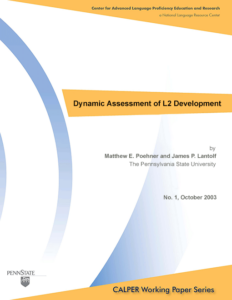
Publication Units:
Dynamic Assessment of L2 Development
Dynamic Assessment Resources
Dynamic Assessment related Websites:
Dynamic Assessment – The official Dynamic Assessment website, containing an introduction to Dynamic Assessment, a directory of Dynamic Assessment researchers, practitioners, and resource centers, training opportunities, and an extensive bibliography.
The Feuerstein Institute -International Center for the Enhancement of Learning Potential – Reuven Feuerstein’s center for clinical applications of the Mediated Learning Experience approach to Dynamic Assessment.
The Center for Cognitive-developmental Assessment and Remediation – established by Boris Gindis, this center applies Dynamic Assessment principles with internationally adopted children and their families.
The International Center for Mediated Learning – built upon the Mediated Constructivism Theory, also known as the MindLadder model, a Dynamic Assessment application developed by Mogens and Myltreda Jensen and inspired largely by Feuerstein’s Mediated Learning Experience. This site provides information for school districts interested in establishing MindLadder programs.
The Southeastern Center for the Enhancement of Learning – located in Atlanta, GA, this center is affiliated with Reuven Feuerstein’s International Center for the Enhancement of Learning Potential and offers clinical services and training in Feuerstein’s Mediated Learning Experience.
Vygotsky related Websites:
http://webpages.charter.net/schmolze1/vygotsky/vygotsky.html [highly recommended]
This page offers a very thorough set of materials on Vygotsky’s life and his theory along with links to the work of his most influential colleagues and those whose theories of mental development interface with his, including Bakhtin, Piaget, Luria, and Ilyenkov. Explanations of such important concepts as mediation, collaboration, semiotic activity, and inclusion can also be found. Finally, the page contains links to studies where Vygotskian principles have been put into practice in the educational setting.
http://www.kolar.org/vygotsky/
This page offers biographical information on Vygotsky as well as a photo archive of Vygotsky and his colleagues and students. It contains links to a theory into practice data base as well as a critical review and analysis of his most well known work Thought and Language. It also provides a discussion of egocentric speech as well as the dialectical method. Unfortunately, some of the links have been broken, but what is still available is quite informative.
http://www.funderstanding.com/vygotsky.cfm
This page provides a brief but informative overview of Vygotskian principles with special focus on their application to education. It is a good first place to go for someone who is not that familiar with Vygotsky’s theory.
http://www.massey.ac.nz/~alock/virtual/project2.htm
http://starfsfolk.khi.is/solrunb/vygotsky.htm
This is another good overview page for those unfamiliar with Vygotsky’s writings. It also provides links to others who have been influenced by Vyogotsky’s theory, including Jerome Bruner and Reuven Feuerstein.
http://carbon.cudenver.edu/~mryder/itc_data/soc_cult.html
This page contains links to numerous articles on various aspects of sociocultural theory, including some of the most recent publications, reviews of works dealing with the theory, and to the work of people instrumental in developing the theory, such as Luria, Leontiev, Cole, Ratner, Engestrom, Lemke, and Nardi.
References:
Ableeva, R. (2010). Dynamic Assessment of listening comprehension in second language learning. Unpublished doctoral dissertation. The Pennsylvania State University, University Park, PA. Available at Penn State Libraries.
Ableeva R. (2008). The effects of dynamic assessment on L2 listening comprehension. In J. P. Lantolf & M. E. Poehner (Eds.), Socio-cultural theory and the teaching of second languages (pp. 57-86). London: Equinox.
Ableeva, R. (2008). Listening comprehension in foreign language instruction.(CALPER Professional Development Document 0810). University Park, PA: The Pennsylvania State University, Center for Advanced Language Proficiency Education and Research.
Ableeva R. (2007). Assessing listening for development. In R. Alanen & S. Poyhonen (Eds.), Language in action. Vygotsky and Leontievian legacy today (pp. 352-379). Cambridge: Cambridge Scholars Publishing.
Ableeva, R. & Lantolf, J. P. (2011). Mediated dialogue and the microgenesis of second language listening comprehension. Assessment in Education, 18, 133-149.
Aljaafreh, A., & Lantolf, J. P. (1994). Negative feedback as regulation and second language learning in the zone of proximal development. The Modern Language Journal, 78, 465-483.
Antón, M. (2009). Dynamic assessment of advanced second language learners. Foreign Language Annals, 42 (3), 576-598.
Darhower, M. A., & Tharrington, K. (2007). Dynamic assessment in synchronous computer-mediated communication: A case study of L2 Spanish past narration. Unpublished manuscript.
Donato, R. (1994). Collective scaffolding in second language learning. In J. P. Lantolf & G. Appel (Eds.), Vygotskyan approaches to second language research (pp.35-56). Norwood, NJ: Ablex Publishing Corporation.
Erben, T., Ban, R., & Summers, R. (2008) Changing examination structures within a college of education: The application of dynamic assessment in pre-service ESOL endorsement courses in Florida. In J. P. Lantolf & M. E. Poehner (Eds.), Sociocultural theory and the teaching of second languages (pp. 87-114) London: Equinox.
Feuerstein, R., Falik, L., Rand, Y., & Feuerstein, R. S. (2003). Dynamic assessment of cognitive modifiability. Jerusalem: ICELP Press.
Hill, K., & Sabet, M. (2009). Dynamic speaking assessments. TESOL Quarterly 43, 537-545.
Kozulin, A. (1998). Psychological tools: A sociocultural approach to education. Cambridge, MA: Harvard University Press.
Kozulin, A., & Garb, E. (2002). Dynamic assessment of EFL text comprehension of at-risk students. School Psychology International, 23, 112-127.
Kozulin, A., & Gindis, B. (2007). Sociocultural theory and education of children with special needs. From defectology to remedial pedagogy. In H. Daniels, M. Cole, & J. V. Wertsch (Eds.), The Cambridge companion to Vygotsky (pp. 332-362). Cambridge: Cambridge University Press.
Lantolf, J. P. (2009). Dynamic Assessment: the dialectical integration of instruction and assessment. Language Teaching 42, 355-368.
Lantolf, J. P., & Poehner, M. E. (2011). Dynamic assessment in the classroom: Vygotskian praxis for second language development. Language Teaching Research, 15, 11-33.
Lantolf, J. P., & Poehner, M. E. (2007). Dynamic assessment. In N. Hornberger (General Ed.) The encyclopedia of language and education, vol. 7: Language testing and assessment, E. Shohamy (Ed.), (pp. 273-285). Cambridge: Cambridge University Press.
Lantolf, J. P., & Poehner, M. E. (2006). Dynamic assessment in the foreign language classroom: A teacher’s guide. University Park, PA: CALPER Publications.
Lantolf, J. P., & Poehner, M. E. (2004). Dynamic assessment: Bringing the past into the future. Journal of Applied Linguistics 1 , 49-74.
Lantolf, J. P., & Poehner, M. E. (2004). Dynamic assessment in the language classoom. (CALPER Professional Development Document CPDD 0411). University Park, PA: The Pennsylvania State University, Center for Advanced Language Proficiency Education and Research.
Lantolf, J. P., & Thorne, S. L. (2006). The sociogenesis of second language development. Oxford: Oxford University Press.
Lantolf, J.P., & Poehner, M.E. (2007). Language proficiency or symbolic capability: a dialectical perspective. (CALPER Working Paper Series, No. 9). The Pennsylvania State University: Center for Advanced Language Proficiency Education and Research.
Leung, C. (2007). Dynamic assessment: Assessment for and as teaching? Language Assessment Quarterly: An International Journal, 4,257-278.
Lidz, C. S., & Gindis, B. (2003). Dynamic assessment of the evolving cognitive functions in children. In A. Kozulin, B. Gindis, V. S. Ageyev, & S. M. Miller (Eds.), Vygotsky’s educational theory in cultural context (pp. 99-118). Cambridge. Cambridge University Press.
Lidz, C., & Elliott, J. (Eds.). (2000). Dynamic assessment: Prevailing models and applications. Oxford: Elsevier.
Martin, D. (2009). Language disabilities in cultural and linguistic diversity. Bristol, UK: Multilingual Matters.
Minick, N. (1987). Implications of Vygotsky’s theories for dynamic assessment. In C. S. Lidz (Ed.), Dynamic assessment: An interactive approach to evaluating learning potential (pp. 116-140). New York: Guilford.
Poehner, M. E., Zhang, J., & Lu, X. (2017). Computerized dynamic assessments for young language learners. In M. K. Wolf & Y. G. Butler (Eds.), English language proficiency assessments for young learners (pp. 214-233). London: Routledge.
Poehner, M. E., & Lantolf, J. P. (2013) Bringing the ZPD into the equation: Capturing L2 development during Computerized Dynamic Assessment (C-DA). Language Teaching Research, 17 (3), 323-342.
Poehner, M. E. (2011). Dynamic Assessment: Fairness through the prism of mediation. Assessment in Education: Principles, Policy and Practice 18(2).
Poehner, M. E. (2011). Validity and interaction in the ZPD: Interpreting learner development through L2 Dynamic Assessment. International Journal of Applied Linguistics, 21, 244-263.
Poehner, M. E. & Ableeva, R. (2011). Dynamic Assessment. From display of knowledge to engagement in the activity of development. In D. Tsagari & I. Csepes (Eds.), Classroom-based language assessment. Frankfurt: Peter Lang.
Poehner, M. E., & Van Compernolle, R. A. (2011). Frames of interaction in Dynamic Assessment: Developmental diagnoses of second language learning. Assessment in Education: Principles, Policy and Practice, 18 (2).
Poehner, M. E., & Lantolf, J. P. (2010). Vygotsky’s teaching-assessment dialectic and L2 education: The case for dynamic assessment. Mind, Culture, and Activity. An International Journal, 17, 312-330.
Poehner, M. E. (2009). Dynamic assessment as a dialectic framework for classroom activity: evidence from second language (L2) learners. Journal of Cognitive Education and Psychology, 8, 252-268.
Poehner, M. E. (2008). Both sides of the conversation: The interplay between mediation and learner reciprocity in dynamic assessment. In J. P. Lantolf & M. E. Poehner (Eds.), Sociocultural theory and the teaching of second languages (pp. 33-56). London: Equinox Publishing.
Poehner, M. E. (2008). Dynamic assessment: A Vygotskyan approach to understanding and promoting second language development. Berlin: Springer.
Poehner, M. E. (2009) Group Dynamic Assessment: Mediation for the L2 Classroom. TESOL Quarterly, 43 (3), 471-491.
Poehner, M. E. (2007). Beyond the test: L2 dynamic assessment and the transcendence of mediated learning.The Modern Language Journal, 91 , 323-340.
Poehner, M. E. (2005). Dynamic assessment among advanced L2 learners of French. Unpublished doctoral dissertation , The Pennsylvania State University, University Park, PA.
Poehner, M. E., & Lantolf, J. P. (2005). Dynamic assessment in the language classroom. Language Teaching Research 9, 1-33.
Poehner, M. E., & Lantolf, J. P. (2003). Dynamic assessment of L2 development: Bringing the past into the future. (CALPER Working Paper Series, No. 1). The Pennsylvania State University: Center for Advanced Language Proficiency Education and Research.
Schneider, E., & Ganschow, L. (2000). Dynamic assessment and instructional strategies for learners who struggle to learn a foreign language. Dyslexia 6, 72-82.
Sternberg, R. J., & Grigorenko, E. L. (2002). Dynamic Testing. The nature and measurement of learning potential. Cambridge: Cambridge University Press.
Summers, R. (2008). Dynamic assessment: Towards a model of dialogic engagement. Unpublished doctoral dissertation. University of South Florida.
Video:
Introduction to Dynamic Assessment by Center for Advanced Language Proficiency Education and Research (CALPER), on Youtube Click here to watch video
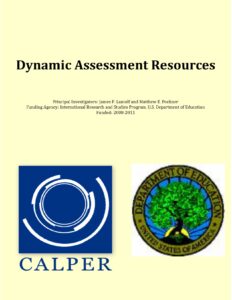
Foreign Language Classroom Assessment in Support of Teaching and Learning
Presentation by Matthew E. Poehner for the LARC/CALPER 2011-2014 Webinar Series on Language Assessment. Author discusses formative assessment and explains some aspects of dynamic assessment.
Gender and Emotional Investment in Language Learning During Study Abroad
CALPER Working Paper Series, No. 2
This paper proposes a relatively nuanced account of the role of gendered activity as it shapes emotional investment in language learning during study abroad. The goal of the current paper is to propose a relatively nuanced account of the role of gendered activity as it shapes emotional investment in language learning during study abroad.
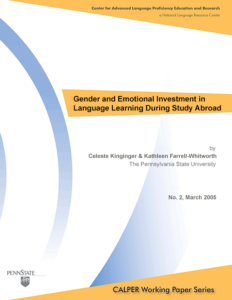
Publication Units:
Gender and Emotional Investment in Language Learning During Study Abroad
High Frequency Vocabulary – Emotion
This unit ‘High Frequency Vocabulary – Emotion” by Victoria Hasko (University of Georgia) is part of a series of materials for intermediate and advanced learners of Russian developed by CALPER. The series focuses on areas of Russian language knowledge central to developing narrative proficiency, i.e. the ability to tell stories.
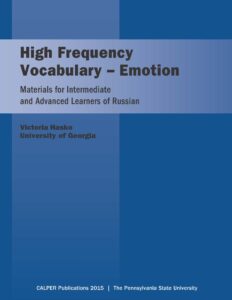
Publication Units:
High Frequency Emotion Vocabulary Items
Publication Files:
How to Use Corpora in Language Teaching
Presentation at the Penn State Language Teaching Workshop Series, 2014 – A breif overview regarding the use of corpora in language teaching.
Integrating Explicit Knowledge into the Second Language Classroom through Concept-based Language Instruction
Integrating Explicit Knowledge into the Second Language Classroom through Concept-based Language Instruction is a series of slides that introduce interested teachers to some background to “Concept-based Language Instruction”. They are only thought of as a preliminary overview. CALPER is currently developing a full website for Content-based Language Instruction. The slides have been prepared by the project coordinator James P. Lantolf.
Revisit the project page for updates.

Internet-mediated Intercultural Foreign Language Education: Approaches, Pedagogy, and Research
CALPER Working Paper Series, No. 6
This working paper focuses on the use of Internet information and communication tools to support intercultural dialogue, debate, collaborative research, and less structured social interaction between (typically) internationally dispersed groups of learners who are members of different linguistic and cultural groups.
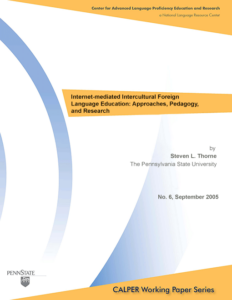
Publication Units:
Internet-mediated Intercultural Foreign Language Education: Approaches, Pedagogy, and Research
Internet-mediated Text and Multi-modal Expression in Foreign Language Education
CALPER Working Paper Series, No. 5
This paper provides a critical review of current trends in the use of technology in second and foreign language education. It also presents a preview that enumerates a number of nascent or near-future possibilities in this area. The authors aspire to provide a synaptic discussion of factors relevant to intermediate and advanced L2 learning mediated by communication technologies.
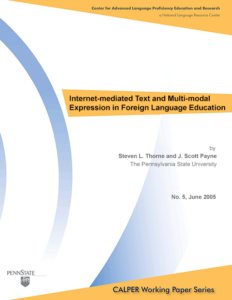
Publication Units:
Internet-mediated Text and Multi-modal Expression in Foreign Language Education
Investigating Assessment Perceptions and Practices in the Advanced Foreign Language Classroom
This paper reports on the research results of a survey conducted in 2005-06 to examine issues relating to advanced language proficiency (ALP) and its assessment in classroom settings. Specifically, it focuses on the views of language teachers of varied backgrounds (in Foreign Languages, and English as a Second Language, at both high schools and universities) on assessment of ALP, and on these teachers’ actual assessment practices.
The report is divided into three components: 1) survey of current thinking about ALP and its assessment in classroom instruction; 2) results of survey that assessed testing perceptions and practices of ALP; 3) conclusions from the theory and research reviewed and recommendations for the direction of future research and practices relating to the assessment of ALP.
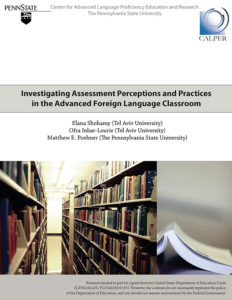
Korean Culture and Media Series
The fundamental goal of this series is to present language and culture as an integral whole—to enhance students’ awareness of language through culture and to deepen students’ understanding of culture through language. Through the materials presented in our Culture and Media Series workbooks, students will be able to acquire and exchange information about Korea and about Korean people. Because we use actual media-based materials designed in Korea for Koreans, students will have the opportunity to observe language and culture in action and to more deeply understand the values and viewpoints that underlie the socio-cultural practices of Korean people.
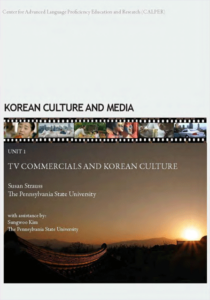
Publication Units:
Unit 1: TV Commercials and Korean Culture
In Unit 1, we present a collection of television commercials, some of which were broadcast in Korea in June 2006. We present these audio-video snippets as cultural artifacts that reflect elements of Korean culture in multiple ways.
Unit 2: A Comparative Approach to Culture through Television Commercials: The Case of Korean and the U.S.
Unit 2 consists of a number of television commercials that were broadcast in Korea and a number of commercials broadcast in the U.S. In each case, we provide samples of commercials for the same type of product. That is, we have representative ads from each country for 1) rice, 2) beer, 3) automobiles, and 4) credit cards.
Unit 3: “The King and the Clown” (Film Series)
We discuss the 조선 Dynasty; the life of 연산군; the Korean caste system; traditional Korean music, dance, theatre, and acrobatic performances; and Korean theatre and film vis à vis theatre and film in other countries.
Unit 4: “Le Grand Chef” (Film Series)
We explain the background of the film’s origins, i.e., a comic strip, a book, and then a television program. We discuss traditional cooking practices, including the traditional kitchen, utensils, foods, and so forth. We also touch on the “language of food” in Korea and the United States, and examine the emergence of cooking competitions around the world. We also examine the genre of the “movie review” in Korea and the U.S.
Unit 5: “Radio Star” (Film Series)
We discuss pop culture in Korea and the world from the point of view of The Korean Wave. We also examine the concept of the pop star in Korea and elsewhere. This unit also compares the Academy Awards with the Blue Dragon Awards in Korea.
Korean Discourse and Genre
The units in the series “Korean Discourse and Genre” are designed to complement existing pedagogical materials for Korean. They contain authentic, media-based samples of actual language used in Korea by Koreans for specific interactional purposes: television programs (e.g., talk shows, reality shows, news, weather reports), radio programs, films, internet-based discourse (interviews, reviews, blogs, news items, recipes), and the like. As the title of the series suggests, the focus of the materials is on Discourse and Genre. Discourse relates generally to language and how language is used in these various communicative contexts. Genre refers to the specific ways in which particular features of language combine to create a certain type of discourse, e.g., conversation, expository writing, formal interview, recipes, weather reports, diary entries, and so forth. All units are based on the newly developed National Standards for Korean.
Korean Holidays
The central theme of Units 1 – 4 are major Korean holidays: 설, 보름, 단오, and 추석. The units open with a brief description of each holiday and its importance within Korean culture. Each unit then branches off in directions that relate these events to other issues in Korean daily life: traditional culture, foods, health and well-being, cultural values and practices, family, travel, weather, and so forth. Each unit is designed to both provide a variety of discourse genres, e.g., expository writing, narrative, recipes, e-mail, interview, chat, blog, and so forth, and have students interact within these various genres. The final section of each unit discusses the specific types of discourse genres used as text in the unit, and isolates particular features of each genre for further study.
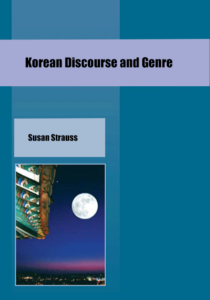
Publication Units:
Korean Holidays
Unit 1. Lunar New Year
Unit 2. First Full Moon of the Lunar Year
Unit 3. Summer Festival Holiday – (5th day of the 5th month in the lunar calendar)
Unit 4. Mid-autumn Festival
Korean Grammar in Discourse and Interaction
Guided activities explaining aspects of Korean grammar from a discourse-pragmatic perspective. Designed for high-intermediate / advanced learners and heritage speakers. Each unit can be used as supplemental materials or for self-study.
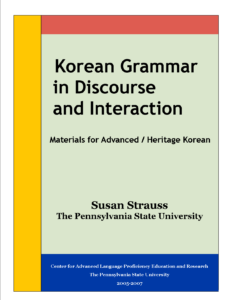
Publication Units:
Unit 1: Completive Aspect Markers
Unit 2: Honorific Speech Levels
Unit 3: Newly Perceived Information
Unit 4: Route Directions
Unit 5: Noun Modifiers
Unit 6: Relative Clause Constructions
Korean News Discourse
Korean News Discourse is a new CALPER project. Instructional materials for high-intermediate and advanced learners of Korean will be developed that focus on typical and critical features of the news genre. The basis for the materials is comprised of a large set of authentic texts, such as traditional newspapers, magazines, TV news broadcasts and online news outlets.
If you are using these materials in your courses, please drop us a line an let us know. Contact Professor Susan Strauss with your feedback.
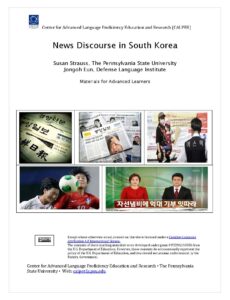
Publication Units:
Korean News Discourse. Unit 1: Introduction
Korean News Discourse. Unit 2: Headlines
Publication Files:
Language Learning in Study Abroad: Case Histories of Americans in France (2008)
Study abroad (SA) has long been understood as a major source of foreign language competence for American students. Based on a large-scale, national assessment project, Carroll (1967) named time spent abroad as one of the most potent variables predicting language proficiency. Based on this solid proof claim, researchers have since investigated language learning in SA using diverse methods and adopting a wide variety of theoretical approaches (e.g., DuFon & Churchill, 2006; Freed, 1995). Over time, concern with general proficiency has given way to studies in which particular aspects of language competence (e.g., fluency, vocabulary growth, pragmatics) are scrutinized in separate studies. The results of these investigations generally show that while SA is certainly a productive context for language learning, its outcomes are neither as dramatic nor as equally distributed among students as one might hope they would be.
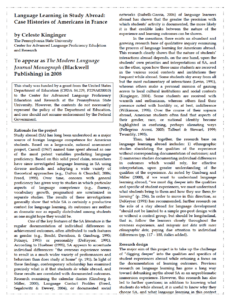
Language Learning in Study Abroad: Case Histories of Americans in France (2009)
Published as: The Modern Language Journal, Volume 92, Monograph, 2008
Study abroad (SA) has long been understood as a major source of foreign language competence for American students. Based on a large-scale, national assessment project, Carroll (1967) named time spent abroad as one of the most potent variables predicting language proficiency. Based on this solid proof claim, researchers have since investigated language learning in SA using diverse methods and adopting a wide variety of theoretical approaches (e.g., DuFon & Churchill, 2006; Freed, 1995).

Language Learning in Study Abroad: Case Histories of Americans in France (2009)
Published as: The Modern Language Journal, Volume 92, Monograph, 2008
Study abroad (SA) has long been understood as a major source of foreign language competence for American students. Based on a large-scale, national assessment project, Carroll (1967) named time spent abroad as one of the most potent variables predicting language proficiency. Based on this solid proof claim, researchers have since investigated language learning in SA using diverse methods and adopting a wide variety of theoretical approaches (e.g., DuFon & Churchill, 2006; Freed, 1995).

Language Proficiency or Symbolic Capability: A Dialectical Perspective
CALPER Working Paper Series, No. 9
A short position paper that argues for a dialectical perspective on language proficiency. Traditional approaches to language proficiency within applied linguistics are based on the dualistic perspective that has been inherited from psychology (Bakhurst, 1991) and that dominates the majority of research in SLA and language education.
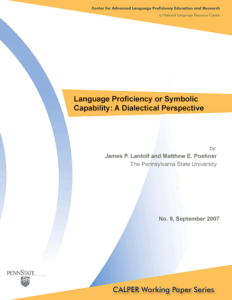
Publication Units:
Language Proficiency or Symbolic Capability: A Dialectical Perspective
Learning through Listening

Publication Units:
PROJECT SITE IS TEMPORARILY UNAVAILABLE – We are currently under revision; thank you for your patience.
Materials designed to help students understand the content, lexical, syntactic and conversation features of natural spoken discourse. Digitized video clips with teaching suggestions and activities. Designed for intermediate to advanced learners of Japanese.
Publication Files:
Listening Comprehension in Foreign Language Instruction
CALPER Professional Development Document CPDD 0810
This document addresses a range of theoretical and practical issues concerned with the teaching of listening comprehension. It provides an overview of the processes involved in listening comprehension and reviews its most prominent models. In addition, this document presents an alternative model of L2 listening comprehension and examines three major approaches to listening comprehension. Finally, it discusses how teachers can make sound pedagogical choices on how to teach and assess students’ listening comprehension skills.
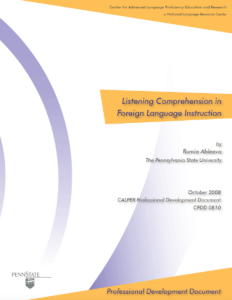
Publication Units:
Listening Comprehension in Foreign Language Instruction
Publication Files:
Metaphor and Pedagogy
CALPER Working Paper Series, No. 11
In this working paper, the potential relevance of metaphor and metaphorical competence for L2 teaching and acquisition are outlined. The authors explain the main claims of conceptual metaphor theory, discuss structural components of conceptual metaphor and contrast conceptual metaphor and linguistic metaphor as two distinct phenomena and consider the two types of conceptual metaphor — primary and complex. Lastly, the authors present some ways of adapting conceptual metaphor for pedagogical purposes.
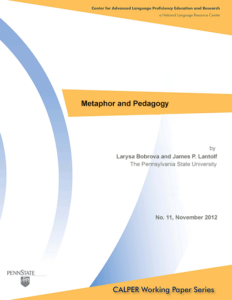
Metaphors in Korean
Metaphors in Korean is part of the units developed in the project ‘Metaphoric Competence in the Foreign Language Classroom.”
The unit contains guided activities that help students first study metaphorical associations and explore how associations may differ cross-culturally. The students are introduced to some expressions connected with the respective metaphors and they learn about their meanings. Students will learn to identify, interpret, and produce metaphoric language in their L2.
Background information is available in:
Bobrova, L., & Lantolf, J. P. (2012). Metaphor and Pedagogy (CALPER Working Paper Series, No. 11). The Pennsylvania State University: Center for Advanced Language Proficiency Education and Research. Available as a free download on our site under “Publications“.
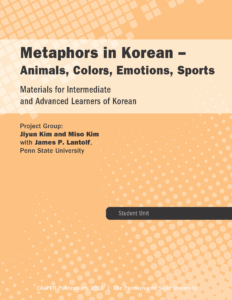
Publication Units:
Metaphors in Korean – Animals, Colors, Emotions, Sports
(1) Student Unit
(2) Dictionary
Publication Files:
Metaphors in Russian
Metaphors in Russian is part of the units developed in the project ‘Metaphoric Competence in the Foreign Language Classroom.”
The unit contains guided activities that help students first study metaphorical associations and explore how associations may differ cross-culturally. The students are introduced to some expressions connected with the respective metaphors and they learn about their meanings. Students will learn to identify, interpret, and produce metaphoric language in their L2.
Background information is available in:
Bobrova, L., & Lantolf, J. P. (2012). Metaphor and Pedagogy (CALPER Working Paper Series, No. 11). The Pennsylvania State University: Center for Advanced Language Proficiency Education and Research. Available as a free download on our site under “Publications“.
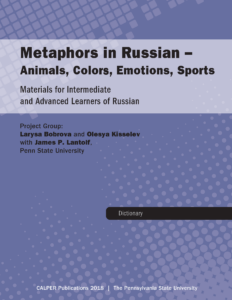
Publication Units:
Metaphors in Russian – Animals, Colors, Emotions, Sports
(1) Student Unit
(2) Dictionary
Publication Files:
Model Program for Heritage Spanish Study Abroad
The aim of this project was to support the impact of short-term study abroad for heritage speakers of Spanish by developing an enhancement program. The resulting model program, written in Spanish, is published here as “Curso de preparación para estudiantes de herencia de español en programas de estudios en el extranjero”.
There are five modules to the program (+ handout to module 2 and 5), a bibliography of relevant references, a guide for students and a guide for instructors or administrators.
Please respect the Creative Commons Licence and cite as:
Jimenez Jimenez, A. (2022). Curso de preparación para estudiantes de herencia de español en programas de estudios en el extranjero. University Park, PA: CALPER Publications.
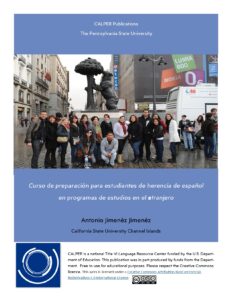
Publication Units:
Module 1: Introduction
Module 2: Heritage Spanish Students – Background
Module 3: Studying Abroad
Module 4: Heritage and Identity
Module 5: Language Development
Bibliography
Publication Files:
Motion Verbs in Narratives
This unit on “Motion Verbs in Narratives” by Victoria Hasko (University of Georgia) is part of a series of materials for intermediate and advanced learners of Russian developed by CALPER. The series focuses on areas of Russian language knowledge central to developing narrative proficiency, i.e. the ability to tell stories. An introduction to developing narrative proficiency has been published as “Advancing in Russian Through Narration” by Aneta Pavleno and Victoria Driagina (CALPER Publications 2008).
Other units in this series:
Tense and Aspect in Narratives
High Frequency Vocabulary – Emotion
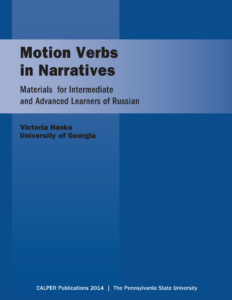
Narrating in Korean
This instructional resource, designed for high school and college level teachers of Korean, provides an entire set of materials that can be used in the classroom for multiple purposes:
Investigate how native speakers of Korean tell narratives by introducing participants in a story, expressing a sequence of events, indicating a cause or effect, presenting personal stances and/or perspectives, and choosing context-appropriate nouns, verbs, and particles.
Have students produce their own extended narratives based on a specific story by learning new vocabulary, learning grammatical constructions for event sequences, learning grammatical constructions for cause and effect, learning overall narrative structure, including beginnings and endings, and telling narratives orally or writing the story on paper.
This can be used for a variety of other classrooom activities including, listening comprehension (comprehension questions / dictation), vocabulary games (bingo, jeopardy, concentration), grammar games, supplementary review of particles, and supplementary review of tense and aspect marketing. Please consider working on new narratives using structures and grammar features from this lesson.
What this instructional resource provides:
- A short six-minute film (The Pear Film, Chafe (1980))
- 3 Native Speaker audio files
- 1 Heritage Speaker audio file
- 8 Intermediate-Advanced learner audio files
- 1 full transcript of a native speaker narrative
- 3 full transcripts of intermediate-advanced student narratives
- a resource guide with ideas for how to use the film, the audio files, and transcripts
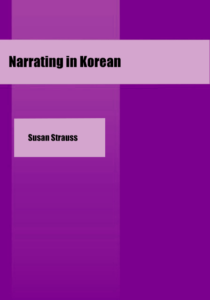
New Media Literacies, Online Gaming, and Language Education
CALPER Working Paper Series, No. 8
This paper describes second and foreign language uses of Internet communication tools, web environments, and online gaming, and critically reviews existing research and emerging technologies representing diverse pedagogical conditions in two main areas: (1) interaction in ongoing Internet-mediated environments that include popular culture blogs and web sites, fan fiction communities, language and/or culture communities; and (2) multi-user online games, including a case study of multilingual communication within a gaming environment.
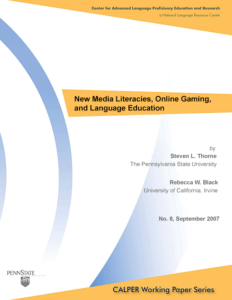
Publication Units:
New Media Literacies, Online Gaming, and Language Education
New Technologies and Additional Language Learning
CALPER Working Paper Series, No. 7
This working paper is a review essay in which the author discusses a number of contexts and uses of technologies, generally Internet communication technologies, as they have been and are being used in second and foreign language education environments. Three primary areas of research and pedagogical innovation are addressed, 1) the use of synchronous computer-mediated communication (CMC), 2) Internet-mediated intercultural L2 education, and 3) additional language learning as a function of participation in Internet-supported communicties such as online fora, fan sites, fan fiction sites, and online gaming.
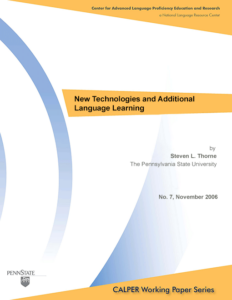
Publication Units:
New Technologies and Additional Language Learning
Publication Files:
Project Work: ESL
Project Work: ESL
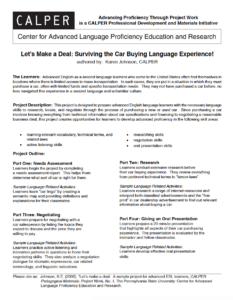
Publication Units:
ESL/EFL:
Let’s Make a Deal!: Surviving the Car Buying Language Experience!
This project is designed to prepare advanced English language learners with the necessary language skills to research, locate, and negotiate through the process of purchasing a new or used car. Since purchasing a car involves knowing everything from technical information about car specifications and financing to negotiating a reasonable business deal, this project creates opportunities for learners to develop their proficiency further.
Publication Files:
Project Work: German
Project Work: German
13 Jahre Deutsche Vereinigung: A Sample Project for Advanced Learners of German
This group project is an “inquiry project”, in which students research in-depth the continuous process of unification in Germany. Students’ research develops from a text (a speech), which they read initially. In this speech, several key issues surrounding German unification are raised, which can be transformed into project questions or sub-topics worth investigating. After identifying key concepts, students select a set of sub-topics to be researched and do so in small groups. The product, which they develop is a written report on their sub-topic and an oral presentation. Author: Gabriela Appel, Penn State University. 2003 – See more at: http://calper.la.psu.edu/content/language-learning-projects-and-project-support-materials#sthash.0qaeOa4P.dpuf
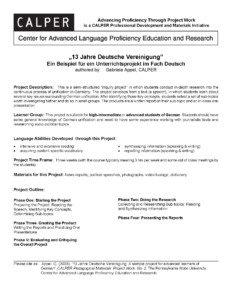
Publication Units:
13 Jahre Deutsche Vereinigung: A Sample Project for Advanced Learners of German
This group project is an “inquiry project”, in which students research in-depth the continuous process of unification in Germany. Students’ research develops from a text (a speech), which they read initially. In this speech, several key issues surrounding German unification are raised, which can be transformed into project questions or sub-topics worth investigating. After identifying key concepts, students select a set of sub-topics to be researched and do so in small groups. The product, which they develop is a written report on their sub-topic and an oral presentation.
Publication Files:
Social and Interactive Perspectives on Japanese Language Proficiency
Mori, J. (2012). Social and interactive perspectives on Japanese language proficiency. University Park, PA: CALPER Publications.
Assumptions about language, language learning, and language learners affect the design of language textbooks and classroom practices. Three main chapters in this monograph explore the gap between how language is represented in textbooks versus how language is used outside the classroom. Focus of the explorations is on “grammar and interaction,” “sociolinguistic variations and the construction of identities,” and “communication styles and intercultural encounters.” A final chapter discusses pedagogical implications, what can and cannot be accomplished inside and outside the classroom and how the two types of learning environments can be linked to each other in order to enhance the quality of the language learning experience.
Guided observations of video-recorded interactions among speakers of Japanese are presented to encourage reflection on assumptions and to illustrate language use outside of the classroom.
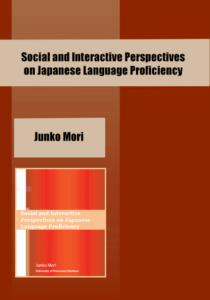
Spanish Heritage Speakers in Study Abroad Programs
This Guide can be used by students preparing for study abroad and administrators of study abroad programs. It has three parts.
Part 1: Understanding Heritage Speakers provides a general overview of Spanish Heritage Speakers (SHSs) in the U.S. context.; analyzes some statistical data on the Hispanic and Latino population; discusses some factors that influence the proficiency level of SHSs. It concludes with some of the obstacles that may cause heritage learners to opt out of study abroad programs.
Part 2: Fostering Language Development discusses some linguistic characteristics that are typically exhibited by SHSs; analyzes some barriers that SHSs often encounter in study abroad programs when trying to develop their language skills in Spanish; presents pedagogical considerations and strategies.
Part 3: Fostering Cultural Adjustment provides information and ideas on how to enrich the cultural experience of heritage speakers in study abroad programs. This includes managing perceptions and expectations from the point of view of both heritage speakers and the host community (including host families, instructors, staff, etc.). Three opportunities to enhance heritage speakers´ cultural experience while abroad are discussed: service learning, voluntary work, and internships.
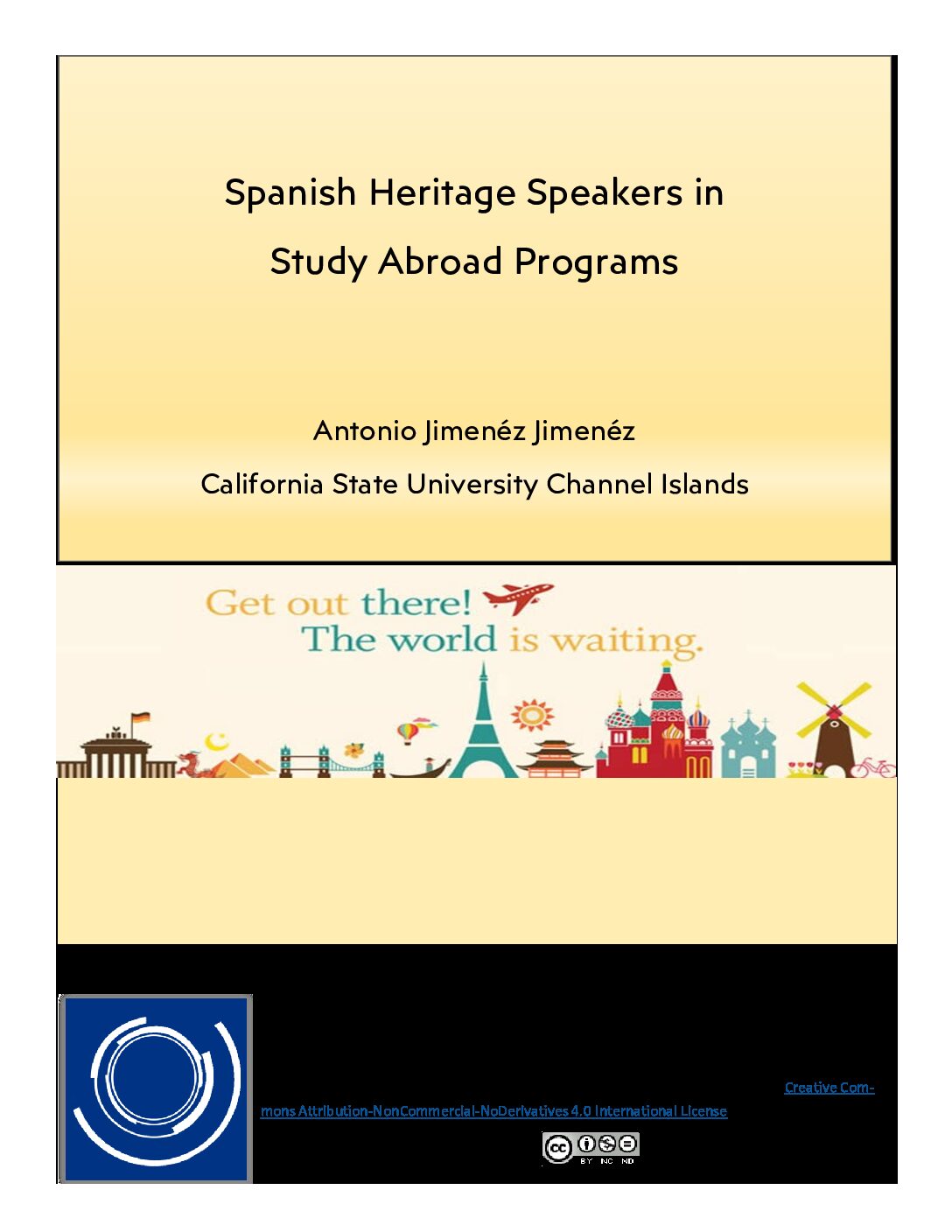
Publication Units:
Part 1: Understanding Heritage Speakers
Part 2: Fostering Language Development
Part 3: Fostering Cultural Adjustment
Speech Acts in Films
Speech Acts in Films is a site where students of Mandarin Chinese learn to examine, understand, and practice social language through the medium of film. The primary audience of the materials are low-advanced and advanced learners who completed approximately two years of language instruction. The materials have been developed for blended-learning environments, but can also be used for self-study, or as supplemental materials in traditional instructional settings.
In the materials on this site, we developed exercises, activities, explanations and worksheet for learners to practice speech acts through the content of four rich and entertaining Chinese films. Among other objectives, students will learn how to:
- write a film synopsis
- write a depiction in poetic style
- compare and contrast
- talk about differences and change-of-states
- greet casually
- request help and respond to requests for help
- apologize and receive apology
- persuade someone
Teaching German Modal Particles: A Corpus-based Approach
Teaching German Modal Particles: A Corpus-based Approach offers an approach to the challenges of teaching the usage of modal particles to learners of German that emphasizes awareness raising activities. The worksheets and handouts are sequenced to move learners through a gradual process of inductively noticing patterns of modal particle use, to defining modal particle meanings and usages, to analyzing modal particle use in context, and finally, to deductively using modal particles in extended communicative interactions. All worksheets are followed by answer keys which offer additional explanations about appropriate modal particle usage. The materials have been created on the basis of a collection of authentic communicative computer-mediated interactions that took place between L2 learners of German and native speakers of German.
Teaching German Modal Particles: A Corpus-based Approach is intended for high-intermediate and advanced levels of proficiency and can be used as supplemental materials in a variety of college/university courses.
What educators say:
“Thank you for sharing the German Modal Particles materials! I will be using them from now on with my honor society and German IV students.” Dr. Noelle Andrie, The Pennsylvania Cyber Charter School
Now available as free downloads: All worksheets, answer keys, and handout are now available as free downloadable PDFs. For educational use only. By downloading a PDF, you agree with not reposting or redistributing the materials. Please read “Preface.”
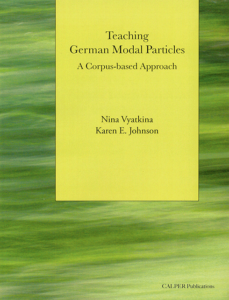
Publication Units:
Preface
A. Noticing Modal Particle Usage
A_WS1 … A_AK1
A_WS2 ….A_ AK2
B. Defining Modal Particles
B_H1
B_H2
B_H3
B_H4
B_H5
D_WS2 … D_AK2
E_WS1 … E_AK1
Publication Files:
Teaching Heritage and Domestic Language Learners
This publication is no longer available as a CD. Please take a look at our updated websites on:
1. Understanding Heritage and Domestic Language Learners by K. E. Johnson and J. Kelly Hall
2. Understanding Teachers of Heritage and Domestic Language Learners by K. E. Johnson and J. Kelly Hall
Teaching Heritage and Domestic Language Learners combines case-based learning with multimedia technology. It is organized around five conceptual strands:
– Teacher’s Voice
– Students’ Voices
– Instructional Challenges
– Instructional Strategies
– Explorations
The resource provides a window into actual language classrooms, showcasing the complexities of addressing the needs of both heritage and domestic learners in the same language course.
The development of this resource was motivated by addressing two significant needs unique to teachers who teach both heritage and domestic language learners in college/university less-commonly-taught language (LCTL) classrooms:
– to understand the pedagogical challenges for a teacher in such learning environments
– to use this understanding to create effectual learning communities in those classrooms.

Tense and Aspect in Narratives
This unit on “Tense and Aspect in Narratives” by Victoria Hasko (University of Georgia) is part of a series of materials for intermediate and advanced learners of Russian developed by CALPER. The series focuses on areas of Russian language knowledge central to developing narrative proficiency, i.e. the ability to tell stories. An introduction to developing narrative proficiency has been published as “Advancing in Russian Through Narration” by Aneta Pavleno and Victoria Driagina (CALPER Publications, 2008).
Also available in this series are:
Motion Verbs in Narratives
High Frequency Vocabulary – Emotion
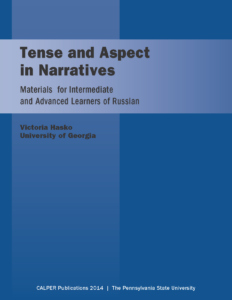
The Korean Wave
Audiences around the world are now enjoying media products of The Korean Wave, including the wide variety of K-Drama, movies, and K-Pop. K-Dramas are broadcast not only in South Korea, but also in Japan, China, Indonesia, the Philippines, Iran, Kuwait, UAE, all throughout North and South America, and parts of Africa, including Zimbabwe and Ghana. K-Pop music has fan followers from small, rural villages to ultra modern metropolises, literally spanning the globe.
The six units in this newest series focus on The Korean Wave. Units 1, 2, and 3 provide a general history and overview of The Korean Wave as well as rich samples of K-Drama excerpts, like scripts and links to video clips, and
activities to explore the discourse and compare and contrast cultural practices and products. Units 4, 5, and 6 document the history of K-Pop and provide an overview of this music genre, with a specific focus on two modern idol groups, BUZZ and EXO. Here you’ll find a robust sampling of news releases, fandom blogs, and song lyrics, also with links to selected music videos. The materials contain a variety of activities for students to explore and experience K-Pop song lyrics, fans’ reactions to their favorite groups, and bits of information on behind-the-scenes production and management operations.
Like all of the units in our Discourse and Genre series, The Korean Wave units match the goals of the Korean National Standards and are designed for teachers and students to work toward increasing proficiency in the 5Cs, while working with a complex set of discourse-based materials and activities.
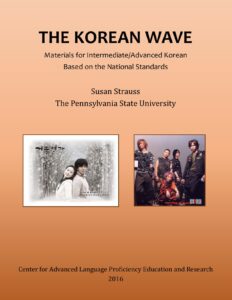
Publication Units:
Korean Drama
Winter Sonata
You’re Beautiful
K-Pop
K-Pop BUZZ
K-Pop EXO
The Language Assessment Process: A “Multiplism” Perspective
CALPER Professional Development Document CPDD 0603
The authors describe the ‘language assessment process’ and emphasize its ‘multiple’ components and phases and the decisions a teacher has to make at each phase. They then discuss the multiple purposes of assessment, possible language assessment tools, multiple assessment methods and ways of administering assessment, multiple ways of designing items and tasks, multiple criteria for determining the quality of assessment procedures, and multiple ways of interpreting and reporting results.
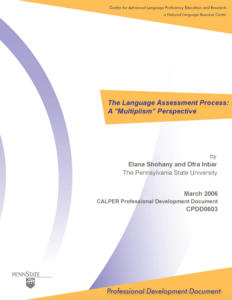
Publication Units:
The Language Assessment Process: A “Multiplism” Perspective
Publication Files:
Understanding Heritage and Domestic Language Learners
Johnson, K. E., & Hall, J. K. (2010). Understanding heritage and domestic language learners. University Park, PA. CALPER Publications.
Understanding Heritage and Domestic Language Learners combines case-based learning with multimedia technology. It is organized around six conceptual strands:
– Descriptions of learners’ backgrounds and prior experiences
– Perceptions of heritage/domestic definitions and distinctions
– Motivation for language study
– Perspectives on their strengths/weaknesses as language learners
– Descriptions of learners’ plans for the future
– Explorations
The resource provides a window into actual language classrooms, showcasing the complexities of addressing the needs of both heritage and domestic learners in the same language classroom.
Using a Corpus in Language Teaching
CALPER Professional Development Document CPDD 0410
In this document, Michael McCarthy describes what a corpus (plural: corpora) is and which kinds of questions it can help answer. He also explains how frequency lists and collocations generated from a corpus constitute powerful analytical tools for those researching language and language teaching. McCarthy concludes by offering practical applications of corpus in language teaching and his thoughts on the future directions for corpus linguistics.
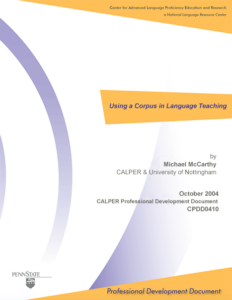
Publication Units:
Using a Corpus in Language Teaching
Publication Files:
Using Corpora in Language Teaching
CALPER Digest
This digest, in addition to defining a corpus (plural: corpora) and briefly describing different types of corpora (e.g., very large, medium-sized, parallel), focuses on learner corpora. The authors emphasize that frequency lists and concordances can help answer questions about why certain patterns of language use happen the way they do. The digest also includes a brief section on data-driven learning (DDL), which is the use and exploration of corpora by students themselves for their own language learning needs.
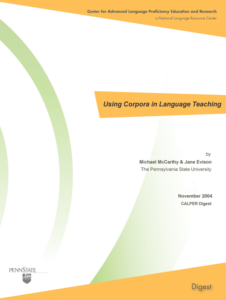
Working with Spoken Chinese
Online purchase is temporarily unavailable. Please contact the CALPER office, calper@psu.edu, if you wish to order the publication.
Working with Spoken Chinese is designed for intermediate to advanced learners (ACTFL Proficiency Guidelines) who want to improve their speaking and listening skills in conversational Chinese. It consists of ten units, which highlight important interactive aspects of the language and provide provide activities and exercises on the grammar of spoken language, the lexicon, and critical features of spoken discourse.
Each unit is accompanied by detailed transcripts, line-by-line commentaries, vocabulary lists, concordances and an audio clip, which are available for free on the companion website to the book.
Unit 1: Travel Adventures 旅行奇遇 – Story Telling, Elements of a Story (Who, When, Where, etc.), Addressee Behaviors in Story Sessions
Unit 2: Fashion Fever 流行装 – Comments on Fashion Styles, Expressing Agreement/Disagreement, Approval/Disapproval, Support Arguments with Examples
Unit 3: Global Citizen 地球公民 – Discussing Attitude toward International Experience, Contrasting Information, Elaborating Information, Supporting Ideas with Examples
Unit 4: Who Wants to be a Millionaire 百万富翁 – Talk about a TV Game Show, Compare Similar and Unlike Things, Degrees and Qualities, Qualifying an Opinion, Vague Expressions
Unit 5: Insurance Abuse 滥用医疗保险 – Commenting on Insurance-Related Social Phenomena, Making Negative Statements, Vague References and Negative Events, Demonstratives and Degree Expressions
Unit 6: Las Vegas 拉斯韦加斯 – Reflecting on a Tourist Destination, Admiration of Places, Contrasting Features of Places, Expressions for Praising, Listener Behavior in Praising
Unit 7: Tough Job Market 就业问题 – Discussing Job Opportunities, Presenting Multiple Reasons/Perspectives, Expressing Past, Present, and Future Temporal Frames of Events
Unit 8: People and Personalities 表情与性格 – Commenting on People’s Appearances and Qualities, Opinions with Different Degrees of Certainty, Personal Interest, Emotional State, Listener Reactions to Comments
Unit 9: Driving Cautiously 小心开车 – Reflecting on Driving Experiences, Different Accounts of Shared Experience, Humor, Alluding to Cultural Concepts
Unit 10: Horror Movies 恐怖片 – Describing a Movie, Types of Movies, Personal Taste about Movies, Liking and Disliking, Listener Corroborating with the Other Speaker
